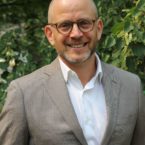Kaposi’s sarcoma associated-herpesvirus (KSHV, also known as human herpesvirus-8) is a gammaherpesvirus that establishes life-long infection in human B lymphocytes. KSHV infection is typically asymptomatic, but immunosuppression can predispose KSHV-infected individuals to primary effusion lymphoma (PEL); a malignancy driven by aberrant proliferation of latently infected B lymphocytes, and supported by pro-inflammatory cytokines and angiogenic factors produced by cells that succumb to lytic viral replication. Here, we report the development of the first in vivo model for a virally induced lymphoma in zebrafish, whereby KSHV-infected PEL tumor cells engraft and proliferate in the yolk sac of zebrafish larvae. Using a PEL cell line engineered to produce the viral lytic switch protein RTA in the presence of doxycycline, we demonstrate drug-inducible reactivation from KSHV latency in vivo, which enabled real-time observation and evaluation of latent and lytic phases of KSHV infection. In addition, we developed a sensitive droplet digital PCR method to monitor latent and lytic viral gene expression and host cell gene expression in xenografts. The zebrafish yolk sac is not well vascularized, and by using fluorogenic assays, we confirmed that this site provides a hypoxic environment that may mimic the microenvironment of some human tumors. We found that PEL cell proliferation in xenografts was dependent on the host hypoxia-dependent translation initiation factor, eukaryotic initiation factor 4E2 (eIF4E2). This demonstrates that the zebrafish yolk sac is a functionally hypoxic environment, and xenografted cells must switch to dedicated hypoxic gene expression machinery to survive and proliferate. The establishment of the PEL xenograft model enables future studies that exploit the innate advantages of the zebrafish as a model for genetic and pharmacologic screens.
Lead Researchers
-
Jason Berman
CEO and Scientific Director of the CHEO Research Institute and the Vice President Research at CHEO
Researchers
-
Jason Berman
CEO and Scientific Director of the CHEO Research Institute and the Vice President Research at CHEO

